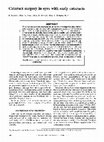Papers by Roberto Bellucci
Ophthalmic Surgery, Lasers and Imaging Retina, 2005
A modified reverse dissection of scleral flaps for glaucoma surgery is described. A conventional ... more A modified reverse dissection of scleral flaps for glaucoma surgery is described. A conventional square or rectangular flap is designed with deep scleral incisions, the two radial incisions crossing the limbus. A horizontal tunnel is created parallel to the limbus within the peripheral cornea, joining the two radial incisions. This tunnel is then enlarged toward the sclera, gradually dissecting the whole scleral flap. This centrifugal cutting is opposite to the common centripetal cutting employed for scleral flaps. Advantages over conventional dissection include more precise dissection within the limbal area, smoother surfaces, and reduction of disturbing bleeding.

Ophthalmologica, 2003
Background and Objective: Patients affected by glaucoma refractory to medical or surgical treatme... more Background and Objective: Patients affected by glaucoma refractory to medical or surgical treatment are difficult to treat. The aim of this study was to evaluate the long-term effect of contact transscleral diode laser cyclophotocoagulation (DLPC) on intraocular pressure (IOP) and on visual acuity of these patients. Patients and Methods: One hundred and twenty eyes of 107 patients suffering from refractory glaucoma and treated with DLPC were followed at the Eye Clinic of Verona University for an average of 26 ± 8 months. Mean age was 57 ± 26 years. IOP, visual acuity, and ocular complications were analyzed. Results: A total of 207 treatments were given. More than one treatment was given in 55 eyes (45.8%). Mean pretreatment IOP was 30.4 ± 3.1 mm Hg. At the last follow-up, mean IOP was 20.3 ± 1.8 mm Hg. Mean total medications were reduced from 4.5 ± 0.5 to 2.3 ± 0.3. No serious complications occurred in the 207 treatments. Visual acuity remained stable in 66 eyes (55%), improved in 2...

Journal of Ocular Pharmacology and Therapeutics, 1995
This study investigated the effects of apraclonidine hydrochloride 1% eye drops on blood-aqueous ... more This study investigated the effects of apraclonidine hydrochloride 1% eye drops on blood-aqueous barrier in 108 pigmented rabbits. The effects of pretreatment with dapiprazole and yohimbine, and a comparison with clonidine 0.125% eye drops are also reported. The disruption of blood-aqueous barrier was obtained by argon laser burning of the iris. The degree of permeability of the barrier was deduced by the amount of proteins in aqueous humor 60 min after laser application. Intraocular pressure and pupil diameter were also studied. Protein content in aqueous humor was 0.72 +/- 0.26 g/l in control rabbits that did not receive any treatment; 5.98 +/- 4.23 g/l in rabbits instilled with placebo eye drops and treated by laser burning of iris; 0.43 +/- 0.25 g/l in rabbits that received apraclonidine eye drops prior to laser burning; 2.19 +/- 1.3 g/l in rabbits that received apraclonidine eye drops immediately after laser application; 0.35 +/- 0.08 g/l in rabbits that received apraclonidine 1% eye drops both before and after laser application. Rabbits treated with clonidine 0.125% had a protein content in aqueous humor of 5.45 +/- 2.08 g/l after laser application. Dapiprazole 0.5% eye drops prior to apraclonidine led to a protein content in aqueous humor of 1.93 +/- 2.13 g/l; yohimbine 0.3% eye drops prior to apraclonidine led to a protein content of 0.70 +/- 0.40 g/l. Protein content in aqueous humor was 0.93 +/- 0.36 g/l, 0.82 +/- 0.899 g/l and 1.68 +/- 1.39 g/l in rabbits treated with yohimbine 0.3, 0.6 and 1.2 mg/kg i.v. and then with apraclonidine 1% eye drops. In one group of rabbits, the penetration into the aqueous humor of Evans blue injected intravenously was also studied. Evans blue content in aqueous humor was 0.03 +/- 0.08 mg/100 ml in control rabbits; 0.92 +/- 0.53 mg/100 ml in placebo rabbits treated by laser; and 0.28 +/- 0.19 mg/100 ml in apraclonidine rabbits treated by laser. Apraclonidine eye drops led to a decrease in IOP and prevented IOP rise following argon laser application. Placebo treated rabbits had a 20% increase in IOP following laser application. Apraclonidine-treated eyes showed mydriasis and blanching of the conjunctiva. These effects were not affected by pretreatment with dapiprazole or yohimbine. In these experiments, the treatment with apraclonidine 1% eye drops completely protected the blood aqueous barrier from the disruption caused by laser burning of the iris. The protection was less effective when apraclonidine was applied after laser burnings.

Journal of Cataract & Refractive Surgery, 1995
This prospective study assessed visual results and subjective rehabilitation after cataract surge... more This prospective study assessed visual results and subjective rehabilitation after cataract surgery in eyes with a preoperative acuity of 0.4 (20/40) or better. Fifty eyes (50 patients) were entered in the study. Corrected and uncorrected visual acuity, lens opacity, glare disability, and contrast sensitivity were measured before surgery and four months after surgery. Patient satisfaction was also measured. Best corrected visual acuity was 0.54 ± 0.12 before surgery and 0.95 ± 0.15 four months after surgery. Uncorrected visual acuity was 0.24 ± 0.18 before and 0.58 ± 0.27 after surgery. Impairment of corrected visual acuity from glare decreased from 0.12 ± 0.09 before surgery to 0.04 ± 0.08 four months after surgery. Contrast sensitivity at 6 cycles/degree increased from 2. 71 ± 0.94 units to 4. 73 ± 1.09 units. After surgery, 62% of patients judged their vision to be greatly improved, 32% judged it improved, 6% judged it unchanged. The patient's satisfaction was partially related to the improvement in uncorrected visual acuity. We conclude that cataract surgery can benefit eyes with limited visual impairment if the surgery is uncomplicated and IOL power is calculated correctly.
Journal of Cataract and Refractive Surgery, 2005

Journal of Cataract and Refractive Surgery, 2001
To assess phacoemulsification and posterior chamber intraocular lens (IOL) implantation as an eff... more To assess phacoemulsification and posterior chamber intraocular lens (IOL) implantation as an effective, safe, and predictable technique for the correction of high myopia. University Eye Clinic of Verona, Verona, Italy. A series of 25 eyes with myopia higher than -12.0 diopters (D) had clear lens extraction by phacoemulsification and IOL implantation in the capsular bag. The mean postoperative follow-up was 42.92 months +/- 3.76 (SD). No serious intraoperative complications occurred. Uncorrected visual acuity improved in all cases. The mean postoperative best corrected visual acuity improved by an average of 1 line. One case (4.0%) of postoperative retinal detachment (RD) occurred at 12 months. One case (4.0%) of biometric error (3.0 D) occurred. Clear lens extraction by phacoemulsification and IOL implantation in a series of highly myopic eyes was effective and had an acceptable predictability and a low rate of complications. Careful evaluation of the retinal periphery by indirect ophthalmoscopy is recommended to avoid postoperative RD.
Journal of Cataract & Refractive Surgery, 1997
Purpose: To study the efficacy of combined diclofenac 0.1 % and gentamicin 0.3% (Oigen) eyedrops ... more Purpose: To study the efficacy of combined diclofenac 0.1 % and gentamicin 0.3% (Oigen) eyedrops to treat postoperative inflammation and prevent ocular infection in eyes having phacoemulsification.
Albrecht von Graefes Archiv f�r Klinische und Experimentelle Ophthalmologie, 1979
The intraocular pressure lowering effects of nine beta-adrenergic receptor blocking agents were c... more The intraocular pressure lowering effects of nine beta-adrenergic receptor blocking agents were compared using two different models of experimental ocular hypertension in rabbits. All the nine drugs possess, to different extents, a clear pressure-lowering action after topical administration into the conjunctival sac. For potency and duration of action, the best results were obtained with timolol and sotalol. Pindolol, oxprenolol, practolol, and propranolol are also fairly potent, while less impressive effects were produced by atenolol, butidrine, and metoprolol. With the exception of propranolol, all the drugs were well tolerated by the ocular tissues.
Acta Ophthalmologica Scandinavica, 2009

Ophthalmic Surgery, Lasers and Imaging Retina
We compared three nucleus delivery procedures used during extracapsular cataract extraction (ECCE... more We compared three nucleus delivery procedures used during extracapsular cataract extraction (ECCE) after capsulorhexis in 142 eyes. In 25 eyes, the nucleus was expressed through a capsulorhexis 7 mm or wider. In 40 eyes, the nucleus was broken into two pieces and removed through a capsulorhexis 6 mm or less. In 77 eyes, viscoexpression was used to remove the nucleus from the capsular bag through a capsulorhexis 6 mm or less. Nucleus expression after a wide capsulorhexis was successful in 68% of the eyes in which it was attempted. Nucleus fragmentation was successful in 90%. Postoperative inflammation was high in both of these groups. Nucleus viscoexpression was successful in 93%, with low postoperative inflammation. Although it requires a 7- to 8millimeter corneoscleral incision, based on our study, viscoexpression would appear to be the best nuclear delivery technique when ECCE, rather than phacoemulsification, is being performed.











Uploads
Papers by Roberto Bellucci